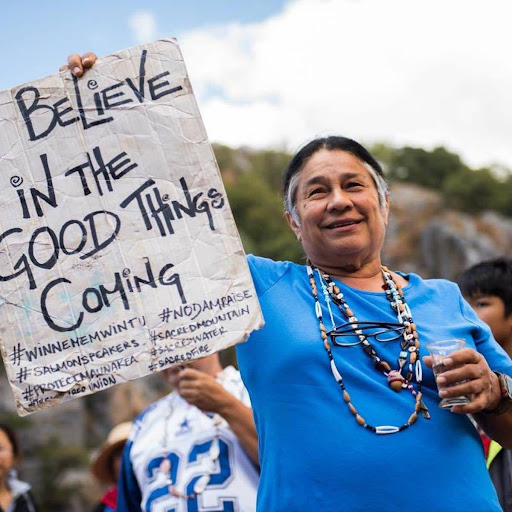Overview
The Winnemem Wintu: A Story of Resilience

Author: Nichelle Garcia, Winnemem Wintu and Dessa Drake, Winnemem Wintu; Marc Dadigan, researcher/reviewer; Chief Caleen Sisk, Winnemem Wintu, reviewer; Will Doolittle, media producer.
Lesson partner: Rebecca Lowry, Humboldt County Office of Education
Grade: 4
Suggested Amount of Time: 2 - 50+ minute sessions
Curriculum Themes
- History
- Cultural Strengths
- Law/Government
- Relationship to Place
- Cross Curricular Integration
Learning Goals
- Students will be able to locate Winnemem Wintu homeland, gain an understanding of the tribe’s relationship and obligations to it, and identify significant geographical locations within it.
- Students will be able to describe how the arrival of settlers into Winnemem Wintu homeland affected the tribe.
- Students will be able to identify the historical events that led to a disruption in the traditional lifeways of the Winnemem Wintu.
- Students will be able to describe ways in which the tribe has shown resilience and persevered despite these challenges.
Lesson Overview
This unit introduces students to the Winnemem Wintu tribe and homeland and explores the ways in which the arrival of settlers affected the tribe from contact through the post-statehood era. Each lesson could take 1-2 days to complete.
Teacher Background
In our language, Winnemem Wintu means “middle water people”, and, as our name connotes, our way of life, our past and and our future is inextricably tied to our river, the Winnemem Waywaket, which is also known as the McCloud River in far Northern California. Since time immemorial, we have served as the ecological and spiritual caretakers of our ancestral watershed and its bountiful salmon runs. Our river, which is bounded to the east by the Puiitipom (Pit River) and to the west by the Nomtipom (Upper Sacramento River), is the center of our universe.
It’s not a coincidence that after the waves of state-sponsored attempted genocides starting in 1849, the condition of our river also suffered as our numbers dwindled to about 125 people from an estimated 14,000 prior to contact. After the first governor of California declared a “war of extermination” against Native peoples was “unavoidable”, settlers targeted Winnemem Wintu people with massacres and violent attacks from settlers during the genocidal nascent decades of California’s statehood. To protect our people from bloodshed, Winnemem Wintu leaders signed the Cottonwood Treaty of Peace and Friendship, which would have established a 35-mile square reservation including parts of modern-day Redding. Yet, under duress from settlers who did not want to give up the valuable resources, Congress refused to ratify the treaty, leaving us vulnerable to further violence and removals as many of us had already begun to move to the new reservation. However, because of the fierceness of our warriors, our political acumen, the rugged McCloud River terrain, and the establishment of a federal fish hatchery on our river, Winnemem Wintu people managed to maintain a foothold in our homelands for far longer than most California Indians.
The federal government’s construction of Shasta Dam flooded 27 miles of Winnemem peoples’ homes and cultural sites beneath what is now Shasta reservoir and blocked the salmon from returning. To clear the area for inundation, the Bureau of Reclamation and Bureau of Indian Affairs colluded to dispossess an estimated 400 Winnemem Wintu people of their allotments on the McCloud River, leaving them landless, destitute, and heartbroken. A federal act passed by Congress in 1941, the Central Valley Indians Lands Acquisition Act, authorized money and like lands as compensation for the Tribe. Yet a federal Indian agent who investigated the possibility ultimately concluded the Winnemem Wintu would be “served better” if we left the area entirely. Ultimately, the Shasta Dam served as a de facto tool to legally terminate our tribal sovereignty, remove us from our homelands, and suppress our stewardship traditions and responsibilities to the salmon.
The damming continued. After acquiring our unceded lands far upriver of Shasta reservoir, Pacific Gas and Electric erected the McCloud Dam, which strangles our river to a mere fraction of its natural flow by diverting it to the utility’s hydroelectric dams on the Pit River. Yet during this time of diaspora and rupture, Top Doctor and Spiritual Leader Florence Jones held our tribe and traditions together and never allowed us to give up our vision of restoring the McCloud to a Winnemem Wintu salmon river once again. Under her guidance, the tribe was one of the first to utilize the American Indian Religious Freedom Act to revitalize ceremonies in our homelands.
Her successor, Chief Caleen Sisk, led the revitalization of several ceremonies, including the Bałas Chonas, or Coming of Age, ceremony for young women, which is centered around ceremony sites within our homeland. Despite limited resources, the tribe has also steadfastly advocated for healthier watersheds, the enforcement of just water quality standards throughout the state, and the restoration of salmon to the McCloud River.

